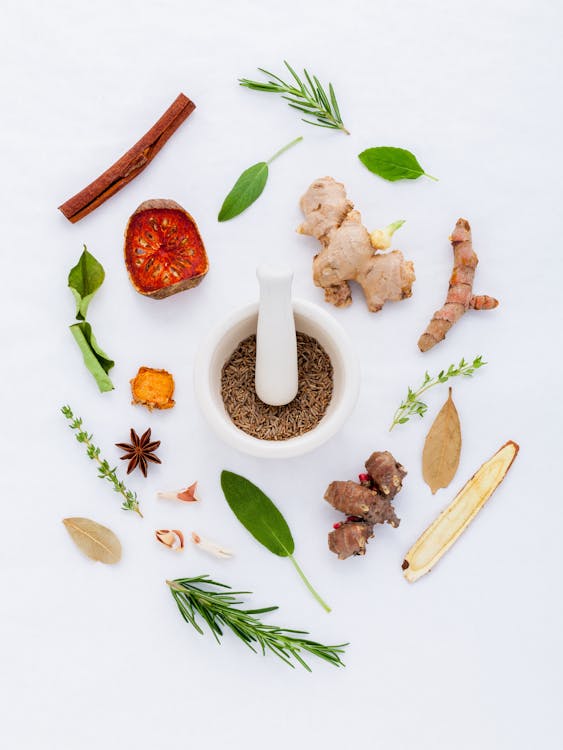People have used dried herbs to make incense, smudges, and herbal smoking blends for a long time. The herbal smoke blend is an excellent way of helping anyone trying to reduce tobacco consumption. It also has health benefits that can treat some ailments.
There are hundreds of herbs documented for use as smoke in different forms. When you combine several tasty herbs with relaxing properties, you can smoke them while enjoying their benefits. The herbs will produce a smooth and tasty smoke with the right blend that will give you a relaxing buzz. Here is everything you need to know about making a smokable herbal blend.
How to create a herbal smoke blend

Image source: https://www.pexels.com/photo/photo-of-ceremonial-tea-set-on-wooden-surface-461428/
Herbal smoking blends encompass herbal cigarettes, vape liquids, and pipe tobacco alternatives. You can customize the mix by combining different ingredients such as calming herbs, expectorants, and other healing plants. Think of the smokable herbs in three parts. The base herbs, those with a specific supportive role, and herbs used for flavoring. Your creativity in making the smoke mix can be a virtue that gives you an incredible feel.
Choose your base

Image source: https://www.pexels.com/photo/close-up-photo-of-person-pouring-freshly-made-matcha-drink-5946637/
The first step is to choose a base, which is ideally light. It should be something smooth and burn well. You can experiment with a combination of these herbs when developing your home recipe.
For example, Mullein is a perfect herb for the base of your smokable herbal blend. It is a highly medicinal herb that cleanses lung inflammation. Adding it to your mix will help when seeking to quit smoking since it can restore your lungs. Also, the raspberry leaf can provide a fluffy base for a smoking blend. It is a sedative herb and will provide a calming effect on your nervous system when smoking the blend.
Blend raspberry lead with Mullein to enjoy a better base for your mix. You can add a third herb such as Damiana if it can add a relaxing effect. Mix with a bit of water to freshen the leaves before using. If the base herbs are too coarse, powder them in a bowl to ensure you get a smooth herbal mix. This is crucial if you use rolling papers to smoke. If you use a pipe, a coarse blend is allowed.
Choose the modifiers

Image source: https://www.pexels.com/photo/photo-of-assorted-herbs-4113898/
Once you’ve established the base, select modifiers for your smoke blend, these are the second largest herbs in your mix, whose role is to enhance the effect of your base. Choose between 2 and 4 modifiers depending on your desired impact.
The modifiers should have the properties to support your lungs and nervous system. Some popular herbs to consider for the supportive role include Wild Dagga, Thyme, Passionflower, and Marigold. Most of these herbs blend well with other relaxing plants, thus creating a smooth feeling when smoking them.
Mullein, Thyme, Hyssop, Horehound, and Marshmallow are wonderful additions for lung health. Others such as passionflower, mugwort, skullcap, rose, Damiana, catnip, and hops are perfect for the nervous system.
Add a flavor twist
The last step is to add herbs that will provide the flavor twist in your smoke blend. Use them in smaller amounts as they have a sharper taste. The role of these herbs is to finish your mixture with a unique flavor.
Examples are peppermint, spearmint, Lavender, Stevia, Sage, monarda, angelica, and Thyme. However, be careful when using herbs with a robust taste to avoid ruining your blend. If the herb has a strong savor, use it sparingly. For example, consider using spearmint in place of peppermint.
Put them together

Image source: https://www.pexels.com/photo/food-on-white-background-256318/
After having everything in place, the last step is to put them together. Start by nuzzling the base herbs in your hand to fluff them and ensure they carry the other ingredients. The friction of rubbing them together helps fluff the base herbs more. The idea is to make them or powder them for an incredible effect.
Take all the dried herbs and mix them in the correct ratio until everything is evenly mixed. You can decide on the proportion of each herb in your blend. For example, you can measure them in small parts, like tablespoons, and keep notes of the recipe to recreate them in larger quantities.
However, the standard mixing ratio is usually 3 parts base herb, 2 parts modifier, and 1 part flavor twist. For example, if your base is Mullein, place 3 handfuls of the herb in a bowl, take two handfuls of modifiers, and add in the same bowl. Last, use a handful of the flavor twists in the bowl and mix them.
An excellent example of a smokable herbal blend uses 3 handfuls of Mullein, 2 handfuls of horehound, and 1 handful of peppermint leaf. This creates a winter mullein blend when adding a few drops of honey and water. Besides blending the herbs, adding a little moisture helps remove its dryness and makes it palatable.
You may mix over one herb in the base, modifier, or flavor twist. Some people make the smoke more like tobacco by adding weight or other characteristics. If you want to add the body to the blend, consider adding barks and stringent herbs such as blackberry root, willow bark, and Uva Ursi.
Bottom line
This guide can help you make a relaxing herbal smoke blend. There are several herbs you can use in a smokable herbal blend. For example, the common herbs are Mint, Lavender, Lemon Balm, and Mullein. These herbs make a pleasant, tobacco-free smoke and are not addictive. However, smoke blends should be a short-term solution because of the harmful health effects of smoking.
